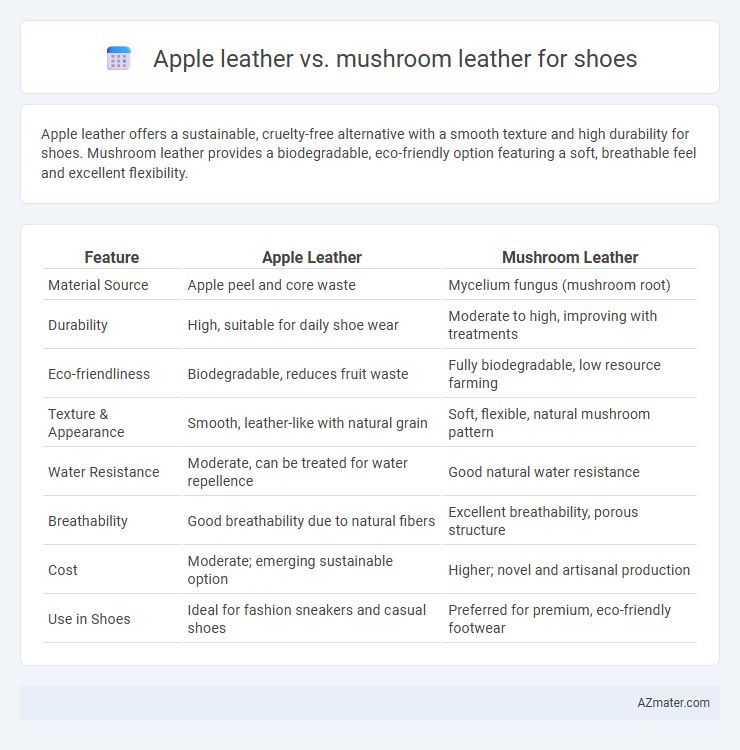Apple leather offers a sustainable, cruelty-free alternative with a smooth texture and high durability for shoes. Mushroom leather provides a biodegradable, eco-friendly option featuring a soft, breathable feel and excellent flexibility.
Table of Comparison
| Feature | Apple Leather | Mushroom Leather |
|---|---|---|
| Material Source | Apple peel and core waste | Mycelium fungus (mushroom root) |
| Durability | High, suitable for daily shoe wear | Moderate to high, improving with treatments |
| Eco-friendliness | Biodegradable, reduces fruit waste | Fully biodegradable, low resource farming |
| Texture & Appearance | Smooth, leather-like with natural grain | Soft, flexible, natural mushroom pattern |
| Water Resistance | Moderate, can be treated for water repellence | Good natural water resistance |
| Breathability | Good breathability due to natural fibers | Excellent breathability, porous structure |
| Cost | Moderate; emerging sustainable option | Higher; novel and artisanal production |
| Use in Shoes | Ideal for fashion sneakers and casual shoes | Preferred for premium, eco-friendly footwear |
Introduction to Alternative Leathers in Footwear
Apple leather and mushroom leather represent innovative alternatives to traditional animal leather in footwear, offering sustainable and eco-friendly options for shoe manufacturing. Apple leather is produced from apple waste left over from juice production, while mushroom leather, or mycelium leather, is crafted from the root structure of fungi, providing a biodegradable and renewable resource. Both materials showcase significant advancements in the alternative leather market, reducing reliance on animal agriculture and decreasing environmental impact in shoe production.
What is Apple Leather?
Apple leather is an innovative, sustainable material made from the byproducts of apple juice processing, primarily apple peels and cores, which are transformed into a durable, leather-like textile ideal for shoe manufacturing. It offers a vegan, biodegradable alternative to traditional animal leather, combining eco-friendly production with a soft, flexible texture that supports breathability and comfort. This material often exhibits a natural aesthetic and excellent resistance to wear, making it a popular choice for environmentally conscious footwear brands.
What is Mushroom Leather?
Mushroom leather, an innovative sustainable material, is derived from mycelium, the root structure of fungi, offering a vegan alternative to traditional leather. This eco-friendly textile mimics the texture and durability of animal leather while reducing environmental impact through biodegradable properties and low resource consumption during production. Compared to apple leather, mushroom leather often provides greater breathability and resilience, making it a promising choice for eco-conscious shoe manufacturing.
Production Processes: Apple Leather vs Mushroom Leather
Apple leather production involves using apple waste from juice manufacturing, which is dried, ground, and combined with polyurethane to create a durable, flexible material ideal for shoe uppers. Mushroom leather, derived primarily from mycelium, is cultivated through controlled fungal growth, then processed into a leather-like material via drying and tanning methods that enhance its texture and strength. Both processes emphasize sustainability, but apple leather relies on agricultural byproducts, while mushroom leather leverages fungal biomass with potential for lower environmental impact due to minimal chemical use.
Environmental Impact and Sustainability
Apple leather, derived from apple waste, offers a lower carbon footprint and reduces agricultural byproduct waste compared to traditional leather production. Mushroom leather, made from mycelium, is biodegradable and requires less water and chemicals, enhancing its sustainability profile. Both materials present eco-friendly alternatives to animal leather, with mushroom leather often praised for faster biodegradability and apple leather for utilizing fruit industry waste.
Durability and Performance Comparison
Apple leather offers moderate durability with good flexibility and water resistance, making it suitable for everyday shoe use but less resistant to abrasion over time. Mushroom leather, derived from mycelium, provides superior durability with enhanced breathability and natural anti-microbial properties, resulting in longer-lasting performance especially in varied environmental conditions. Both materials outperform traditional PU leather in sustainability, but mushroom leather tends to offer better structural integrity and longevity in footwear applications.
Comfort and Breathability in Shoes
Apple leather offers moderate breathability and a soft texture, making it comfortable for casual shoe wear but prone to retaining heat during extended use. Mushroom leather, derived from mycelium, provides superior breathability and moisture-wicking properties, enhancing overall foot comfort and reducing odor in shoes. Both materials deliver eco-friendly alternatives, but mushroom leather excels in maintaining a cooler, more breathable environment inside the shoe.
Aesthetic Appeal and Design Versatility
Apple leather and mushroom leather both offer unique aesthetic appeal and design versatility for shoes, with apple leather showcasing a smooth, glossy finish that mimics traditional leather and mushroom leather providing a matte, textured surface that adds a natural, earthy look. Apple leather's consistent coloration allows for bold, vibrant shoe designs, while mushroom leather's organic patterns give each pair a distinct character, appealing to consumers seeking eco-friendly fashion with a handcrafted feel. Designers prefer apple leather for sleek, modern styles and mushroom leather for rustic, artisanal designs, making both materials versatile in sustainable footwear collections.
Cost Analysis: Affordability and Market Trends
Apple leather typically costs slightly more than mushroom leather due to its established production processes and higher demand in premium footwear markets. Mushroom leather offers a more affordable alternative, benefiting from lower raw material costs and emerging scalable manufacturing techniques, making it appealing for budget-conscious brands. Market trends indicate growing consumer interest in sustainable and cost-effective materials, driving increased investment and price competitiveness in both apple and mushroom leather sectors.
Future Prospects of Bio-Based Leathers in Shoe Industry
Apple leather and mushroom leather represent promising bio-based alternatives in the shoe industry, offering sustainable and biodegradable options that reduce reliance on animal hides and synthetic materials. Advances in cultivation techniques and processing are enhancing the durability, texture, and scalability of these materials, making them increasingly viable for mass-market footwear production. Industry adoption is expected to accelerate as consumer demand for eco-friendly products grows, supported by innovations in plant-based chemistry and circular economy initiatives.

Infographic: Apple leather vs Mushroom leather for Shoe
 azmater.com
azmater.com